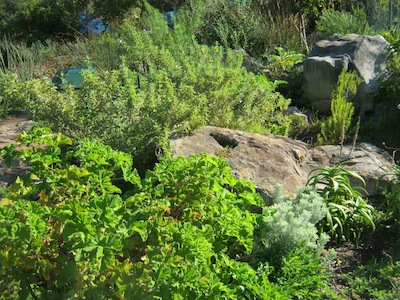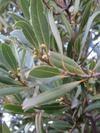Dear Reader, in this age of AI created content, please support with your goodwill someone who works harder to provide the human-made. Sign up at the top of the lefthand column or bottom of this page. You will receive my hand illustrated monthly newsletter RESTORE NATURE and access to the biodiversity garden design course as I write...and nothing else, I respect your time. I am also removing the advertizing as best I can as its become intrusive inappropriate and pays me nothing.
Water-wise planting in Mediterranean gardening
Part 1
Water-wise Mediterranean gardening
This article follows on from an introduction to water-wise Mediterranean gardening and how to prepare through planning and research.
General guidelines on planning your planting to be appropriate to your locality
Spend time on integrating your personal needs for food, green space, beauty, recreation, entertaining and such with the givens in your area that are typical for Mediterranean climates, such as the scarcity of water at certain times, the need in the whole of your society for food security and drinking water, the need to conserve the amazing biodiversity of your local plant biome. Try and plant in a way that serves the greater good. It may seem irrelevant, but what you do in your garden does impact the rest of society and the environment.
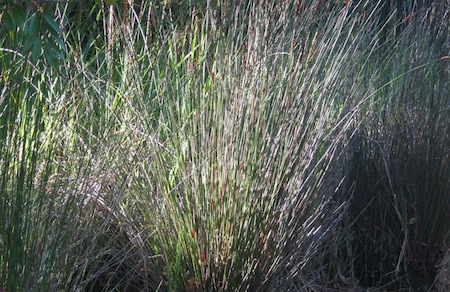 Restios, dominant in Fynbos, are quite gorgeous
Restios, dominant in Fynbos, are quite gorgeousGet real
Profoundly accept the environmental givens in your area, like rocks, buildings, large established plants, climate, soil and learn to see the beauty and love the appearance of local indigenous plant communities in the wild. Van Jaarsveld (2010) in Waterwise gardening in South Africa and Namibia, claims that making a garden appropriate to your area, that is using indigenous vegetation, is the basis of water-wise gardening. Gildemeister (1995) in Mediterranean Gardening: A Waterwise Approach has a looser approach to appropriateness, in that plants from the same climate zones are seen as water-wise.
That they use less water is highly likely as they are adapted to your type of climate. The danger in this adaptation is that they survive in your climate easily, and may become invasive as has happened all around the world when transferring plants to similar climates. Thus I would agree with Van Jaarsveld’s emphasis on indigenous planting. It is the safest and should be the default choice. Most Mediterranean zones are so diverse, one wonders about why people need other plants, beyond the collector’s motive, which is a sort of botanical trophy hunting. Often with dire effects. So sad when it is your local threatened species which need to be trophies in your garden, which we need to propagate to save them from extinction. “Growing local indigenous plants is a positive act of conservation” (Van Jaarsveld 2010:13).
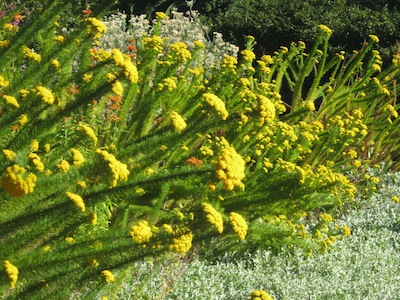 seductive colour in Mediterranean gardening, but all year round its overkill
seductive colour in Mediterranean gardening, but all year round its overkillGet unhooked from ephemera and gardening delusions
Above all aesthetic necessities, do not base your design on artificially that is recreating the appearance of a garden from another climate not compatible with your own without using copious irrigation and soil additives. Do not base the design on ephemera like flowers, as in a showy display of many kinds of orange blooms in April, when the rest of the year the beds looks terrible and creating the ‘orange splash’ required being an ecological violator. Remember flowers are seductive but fleeting, design the backbone of your garden for what is more permanent and add flowers into this. I would suggest prioritizing other design elements such as different materials used in building, foliage colour, form and texture, different heights and degrees of enclosure, the mystery of separated half seen spaces and other structural elements, as well as the recreation of the appearance of natural plant communities in your locality using native plants.
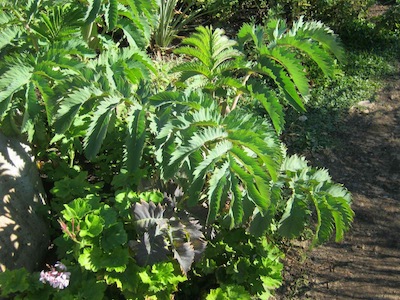 some of the beautiful greenery in our local Mediterranean gardening climes
some of the beautiful greenery in our local Mediterranean gardening climesShould we plan for abundance
in all seasons ?
Gardening books recommend planning the garden for year round attraction. This would mean finding some plants that look good, peak or flower at all times of the year. This is good advice but it can be misapplied in the search to have displays of flowers all year round in an artificial water wasting fashion. Plant choices become skewed to choosing exotics and plants from different rainfall zones, which is less water wise and could lead to using invasive plants like oleander which is spectacular when everything else is brow and crisp. Gildemeister (1995) claims that when the garden is dry and brownish grey, in summer, bright warm colored flowers are spectacular. I think may be water-wiser in our country's climes, so much drier than those of Mediterranean gardening to come to love the way your local vegetation's looks in the dry season.
It is a deeper form of aesthetic delight to accept the beauty of the desert than require constant loud entertainment with pinks and yellows. Gildemeister’s sound advice is to choose evergreen plantings that always look good as a backbone to the garden, and to add to this autumn flowering bulbs and climbers, some plants that flower just after midwinter at the grayest time of year, and of course spring and summer champions. If you walk in the Fynbos at the Cape you will find something flowering at all times of year, because plants will evolve to take gaps like this. Take a photograph (don’t pick it of course, you could stop its seeding and propagation and get arrested) and visit Kirstenbosch National Botanic Garden's nursery to see if they have it for you.
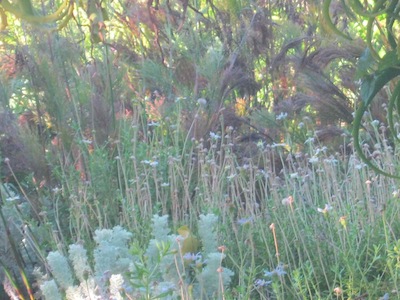 multi-tiered feathery Fynbos planting at Kirstenbosch
multi-tiered feathery Fynbos planting at KirstenboschModel your planting on nature
Observe how local plant communities cover the ground in several height tiers, trees, climbers, bushes and ground cover. Find out what the local indigenous quick growing pioneers would be. Local plants grown in an a fashion recalling their original communities will always look ‘right’ and have a special resonance and a special thrill. To avoid being seduced by ephemeral colour Gildemeister (1995) suggests planning your garden in black and white by moonlight, which sounds quite romantic, but is realistic too.
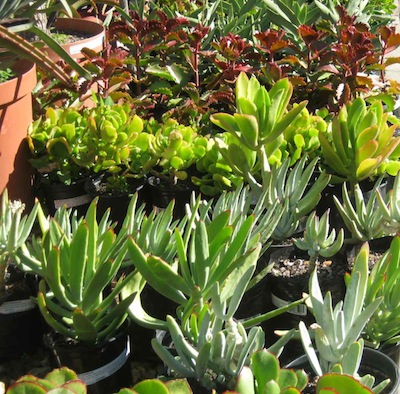 some materials for water-wise Mediterranean gardening
some materials for water-wise Mediterranean gardeningUse native plants
Find out about native plants and how to grow them, especially for the garden’s tough backbone. Plan their placing so that they don’t get overwatered by being near a water demanding plant. One should understand local plant communities. In the Cape they are driven by fire cycles, the nutrient poor soil’s providing non nutritious and fragile vegetation due to the historical absence of large herbivores (VanJaarsveld 2010:12). These conditions of fire, low nutrients and fragility make Fynbos plants generally more difficult in the garden, and the plants from the thicket areas of South Africa with nutrient rich soils and large herbivores and thus plants evolved to survive disturbance and maltreatment, more easy on the gardener. Nonetheless we should take on the challenge of growing Fynbos. A must in a Fynbos garden with possible fire exposure is to plant fire resistant hedges and fire resistant areas around the house. This can be accomplished by using fleshy succulents. Van Jaarsveld’s criteria for plant selection (2010:11) is that the plant should be attractive and thrive under prevailing conditions. I find this vision a bit limiting as I’ll explain. In South Africa with all its floristic diversity, that range of plants which have been horticulturized for the garden and available in nurseries is large but not as complete as it could be. Van Jaarsveld explains some of the mechanisms of the horticultural development of plant species (2010:11). In my opinion the horticultural industry and public taste emphasize the development of showy plants. Our food plants are neglected, as are many plants that are not hugely decorative but perform highly essential ecological functions, like the low growing ground covering legumes that would make perfect garden pioneers. I know of none which can be bought and we have many species of scrambling legumes. The pioneers mentioned by Van Jaarsveld (2010:15, 67) are trees and shrubs. He doesn’t advocate any kind of creeping or annual ground cover pioneers, so essential in early stages, or nitrogen and other nutrient accumulators or green manures. There is no need for nutrient accumulation perhaps because decorative Fynbos plants are averse to excessive nutrients, but this leaves a horticultural lacuna.
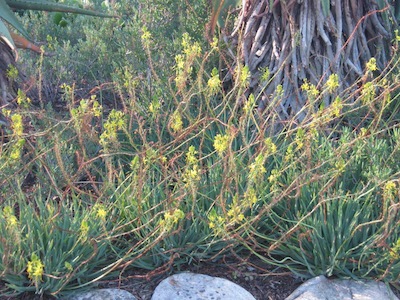 plants used in Mediterranean gardening: Bullbinella is drought tolerant, a ground-cover and medicinal
plants used in Mediterranean gardening: Bullbinella is drought tolerant, a ground-cover and medicinalEcological niches in the food garden
I observe that the organic gardener and farmer looking for green manures resort to invasive exotics, which outcompete our native spring flowers, taking out vast tracts of indigenous vegetation in a more devastating way then Port Jackson and Black Wattle. Choosing attractive and thriving plants for development is not enough. We need to develop indigenous plants with important ecological roles too, like the food plants and legumes, nutrient accumulators and fungi, host plants for important insect pollinators and predatory insects and birds that keep ‘pest’ populations down, soil stabilizers and plants for fuel and wooden construction, for animal feed, sugar production, waste water cleansing and aquaculture crops. In these ‘niches’ in the permaculture garden, exotics not indigenes are the default, except in the creation of IM’s. There is development in the Americas and Australia in the use of indigenes in permaculture, but not much is happening in South Africa. Van Jaarsveld (2010: 37-43) includes a list of approximately 60 indigenous food plants and herbs and a symptom based herbal pharmacopeia with more names. They are good lists but most of them will be really hard to find in nurseries. I’ve also written about Loubie Rusch’s research on local food plants.
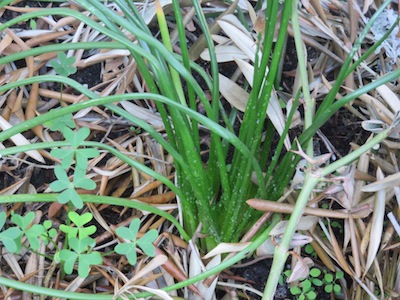 The wild asparagus,Trachyandra and soup flavoring Oxalis
The wild asparagus,Trachyandra and soup flavoring OxalisWater-wise gardening and food plants
The exotic plants which grow easily in your climate pose the threat that they may be invasive. This is specially true of plants which reproduce abundantly by seed which is spread easily, for example by birds. Do some research especially on plants bearing copious fruit. Those which need pampering to survive are less likely to invade, but they are not water friendly. Thus when you use exotics they either pose a threat as invaders or as water guzzlers, sometimes both. Food growing sits right at the core of this problem. South African plants have not been domesticated for human consumption like those from the Americas and Eurasia. Most vegetables in our Mediterranean gardening zone pose little threat of becoming invasive as they can’t survive in our climate without special care. This also makes them the antithesis of water-wise, unless you are very creative with water use. One could also switch to indigenous food plants as far as possible.
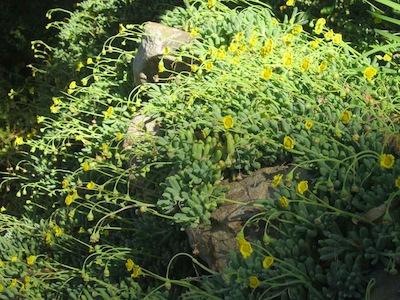 a rocky terrace with excellent drainage provides an ecological niche in Mediterranean gardening
a rocky terrace with excellent drainage provides an ecological niche in Mediterranean gardeningMeet your plants' ecological needs
In addition to meeting the plant’s nutrient requirements, even if this is for a lack of nutrients, reduce water wastage through meeting their ecological needs. Reduce water loss through leaves by keeping shade plants in shade, water lovers at a slope bottom or near sprinklers, or supply good drainage if they like it, for instance along the top of a dry wall. Crowd plants, to create a protective canopy, and cover the soil, and if they have deep roots keep them cool, mulch them well, plant in early autumn. A major help in their initial survival is to plant larger plants from 2-4 litre containers that have already beat the forces that eliminate so many plants at the germination and seedling level. If you plant annuals and geophytes, use those from a region with similar climate patterns, or with a tolerance for summer drought (van Jaarsveld 20110:21).
Next up in the series on water-wise Mediterranean gardening
The next article will be on general guidelines for planting to save water.
------
home page for links to practical useful information on natural gardening
------
natural garden design and its benefits
------
drought tolerant plant adaptions
-----
pictures of Mediterranean gardens around the world
You’re a home gardener ! Share your experiences and questions !
We all know about home gardening. Tell us about your successes, challenges and ask about issues that bother you. You may have the luxury of a back garden, but there are other ways we learn. Few people age without growing something or buying vegetables during their lives ! It is absolutely guaranteed that you have learned things which can help others on their gardening journey.
We invite you to share your stories, ask questions, because if a thing has bothered you it will bother others too. Someone may have a solution ! No question is too small. There is learning for everyone involved, for you, for me (yes, I learn from every question), for us all. Exciting stuff !
We are starting on a new journey. Every week we will profile your letters ! The best stories and questions we receive.
What Other Visitors Have Said
Click below to see contributions from other visitors to this page...
spice trees in Mediterranean climates 




The Laure, Laurus nobilis, loves Mediterranean climates. It was used as a head decoration for heroes in ancient times, hence the laurel wreath, and 'laurels' …
A real global mix of water-wise mediterranean plants. Not rated yet
In this garden which is both a decorative and a functional garden, and a wild mix of native South African and Mediterranean plants, herbs, flowers and …
Restore Nature Newsletter
I've been writing for four years now and I would love to hear from you
Please let me know if you have any questions, comments or stories to share on gardening, permaculture, regenerative agriculture, food forests, natural gardening, do nothing gardening, observations about pests and diseases, foraging, dealing with and using weeds constructively, composting and going offgrid.
SEARCH
Order the Kindle E-book for the SPECIAL PRICE of only
Prices valid till 30.09.2023
Recent Articles
-
garden for life is a blog about saving the earth one garden at a time
Apr 18, 25 01:18 PM
The garden for life blog has short articles on gardening for biodiversity with native plants and regenerating soil for climate amelioration and nutritious food -
Cape Flats Sand Fynbos, Cape Town's most endangered native vegetation!
Apr 18, 25 10:36 AM
Cape Flats Sand Fynbos, a vegetation type found in the super diverse Cape Fynbos region is threatened by Cape Town's urban development and invasive alien plants -
Geography Research Task
Jan 31, 25 11:37 PM
To whom it may concern My name is Tanyaradzwa Madziwa and I am a matric student at Springfield Convent School. As part of our geography syllabus for this
"How to start a profitable worm business on a shoestring budget
Order a printed copy from "Amazon" at the SPECIAL PRICE of only
or a digital version from the "Kindle" store at the SPECIAL PRICE of only
Prices valid till 30.09.2023
